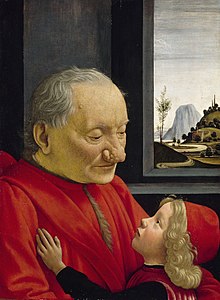User:Mr. Ibrahem/Rhinophyma
| Rhinophyma | |
|---|---|
 | |
| An Old Man and His Grandson, by Domenico Ghirlandaio | |
| Specialty | Dermatology, ENT surgery |
| Symptoms | Enlarged and bulbous nose[1][2] |
| Complications | Basal cell cancer, stigma[1] |
| Usual onset | Older males[3] |
| Causes | Unclear[1] |
| Risk factors | Rosacea[1] |
| Diagnostic method | Examination[3] |
| Differential diagnosis | Basal cell cancer, sarcoidosis, lymphoma, leishmaniasis[3] |
| Treatment | Medications, procedures[1] |
| Medication | Metronidazole, azelaic acid, tetracycline antibiotics, isotretinoin[1] |
| Frequency | 0.1%[4] |
Rhinophyma is a condition that results in an enlarged and bulbous nose.[1][2] The skin can be red, have visible blood vessels, or prominent pores.[1] It can result in psychological stress and trouble breathing through the nose.[3] Other areas including chin, ears, eyelids, and forehead may be similarly affected.[1]
The cause is not clear.[1] Usually it occurs as a complication of rosacea, though may occur following acne.[3][1] It has mistakenly been link with alcoholism.[2] The underlying mechanism involves increased growth of sebaceous glands and connective tissue.[3] Diagnosis is based on examination.[3]
Treatment may include creams such as metronidazole or azelaic acid; or tetracycline antibiotics or isotretinoin by mouth.[1] A number of procedures such as cryotherapy, dermabrasion, and laser therapy may be used.[1] These procedures result in at least short term benefit.[3] Basal cell cancer can occur within a rhinophyma.[1]
One study found about 0.1% of people are affected.[4] The condition is most common in white males over the age of 50.[3] It is uncommon in Asians and Africans.[3] The condition has been described since the 1400.[3] Other terms for the condition include "whiskey nose", "gin blossom", and "potato nose".[3] The condition is frequently associated with stigma.[3]
References[edit]
- ^ a b c d e f g h i j k l m n "Rhinophyma". dermnetnz.org. DermNet NZ. Archived from the original on 26 May 2021. Retrieved 10 June 2021.
- ^ a b c Cohen AF, Tiemstra JD (2002). "Diagnosis and treatment of rosacea". J Am Board Fam Pract. 15 (3): 214–7. PMID 12038728. Archived from the original on 2019-12-15. Retrieved 2021-05-21.
- ^ a b c d e f g h i j k l m Dick, Mary K.; Patel, Bhupendra C. (2020), "Rhinophyma", StatPearls, Treasure Island (FL): StatPearls Publishing, PMID 31335093, archived from the original on 2021-05-20, retrieved 2020-12-24
- ^ a b Rook's textbook of dermatology (Ninth ed.). Chichester, West Sussex: Wiley. 2016. p. 91-3. ISBN 9781118441176.
